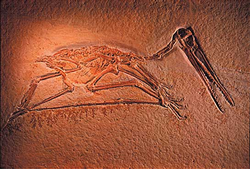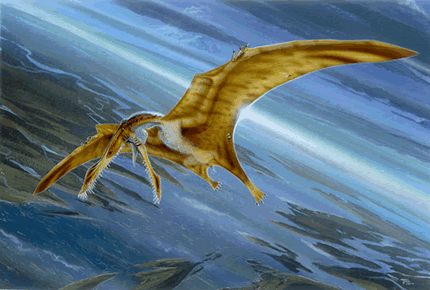Pterosaurs
Homepage > Prehistoric Flying Reptiles - Pterosaurs
Pterosaurs "winged lizards" were a group of flying reptiles of the clade Pterosauria. The earlier species had long, fully-toothed jaws and long tails, while later forms had a stump for a tail, no teeth and a jaw more like a beak than the elongated jaw of the earlier species. At least 60 genera of pterosaurs have been found, ranging from the size of a small bird to wingspans in excess of 40 feet (12 meters). Pterosaur fossils are were difficult to preserve since their bones were hollow, and when sediments piled on top of them, the bones tend to get flattened. The best preserved fossils have come from the Araripe Plateau, Brazil. For some reason, when the bones were deposited, the sediments encapsulated the bones, rather then crushing them.
 This
created three dimensional fossils for paleontologists to study. The first
find in the Araripe Plateau was discovered in 1974. Pterosaur wings were
thin membranes of skin attached to the long fourth finger of the arm and
extending along the sides of the body. A bone called the pteroid connects
to the wrist and helped to support a membrane between the wrist and shoulder.
The pteroid might have been able to swing forward to extend this membrane.
An argument is sustained among paleontologists regarding whether the wings
attached to the hind limbs as well.
This
created three dimensional fossils for paleontologists to study. The first
find in the Araripe Plateau was discovered in 1974. Pterosaur wings were
thin membranes of skin attached to the long fourth finger of the arm and
extending along the sides of the body. A bone called the pteroid connects
to the wrist and helped to support a membrane between the wrist and shoulder.
The pteroid might have been able to swing forward to extend this membrane.
An argument is sustained among paleontologists regarding whether the wings
attached to the hind limbs as well.
This arguments are backed by fossil finds in Sordes and Brazil. When we look at modern animals such as the bats and flying squirrels, they display considerable variation in their wing membranes, and it is possible that the same variation would have been seen in the different species of pterosaur as well. Pterosaur bones were hollow and air filled, like the bones of modern aves. Hollow bones facilitated the flight of these large animals. Fossil finds indicate that some pterosaurs are known to have been attacked by Spinosaurus. The finding showed an early Cretaceous fossil of three cervical vertebrae of a pterosaur with the broken tooth of a Spinosaurus embedded in it.
Time Period and habitats
They existed from the late Triassic to the end of the Cretaceous period
(228 to 65 million years ago).
Mobility
The question remains on how pterosaurs moved about on the ground. Were
they quadrupeds or bipeds? A large number of pterosaur track ways have
been found, with a distinctive four toed hind foot and three toed front
foot; these are track ways of pterosaurs walking on all fours. However,
one cannot conclude that all pterosaurs were quadrupedal, all the time.
Eating Habits
Pterosaurs were carnivores, they ate fish which they caught while skimming
the surface of the oceans, mollusks, crabs, insects, and might also scavenged
dead animals on land.
Discovery
Pterosaurs were first discovered in 1784 by the Italian naturalist
Cosimo Collini. He initially believed that pterosaurs were aquatic reptiles.
In the 19th century Baron Georges Cuvier proposed that pterosaurs were
able to fly. Since the first pterosaur fossil was discovered back in 1784
from the late Jurassic, by Solnhofen limestone, twenty nine kinds of pterosaurs
have been found in those deposits alone. Most paleontologists now believe
that pterosaurs were adapted for active flight, not just gliding as was
believed earlier.

Image courtesy of Todd Marshall